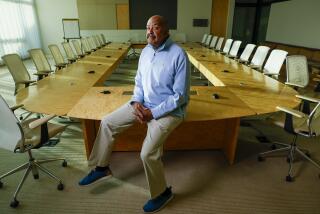On a Mission to Invigorate O.C.’s Mission
- Share via
Faced with the daunting task of attracting a younger generation to Mission San Juan Capistrano, new executive director Mechelle Lawrence turned to her most trusted advisor.
She sent her 11-year-old son, Dylan, on a field trip around the 227-year-old mission. He and a of couple buddies strolled the grounds, giving her an honest assessment via walkie-talkie.
“He told me to beef up the olive press, that it was really boring,” Lawrence said.
“And he mentioned that he couldn’t find anything that told the history of Father Serra. But he did like the cemetery.”
Lawrence took her son’s suggestions and had a few of her own on how to invigorate the county’s third-most-popular tourist attraction, which has been troubled lately by sagging attendance and sagging structures. Weeks after succeeding Jerry Miller in early October, Lawrence decided the mission needed to reshape its own mission.
Founded in 1776 by Father Junipero Serra, the mission is a Roman Catholic church with 5,000 parishioners, one of the largest in Orange County. With about 550,000 visitors a year, the mission trails only Disneyland and Knott’s Berry Farm in attendance.
In addition to the main church that was built in 1987 and accommodates about 1,000, the 10-acre grounds also include an elementary school and the mission, which features Serra Chapel, the Great Stone Church, barracks, a cemetery and museum rooms.
While working as the economic development manager for San Juan Capistrano the last seven years, Lawrence had heard complaints that the mission had become too commercial. Once she got inside, Lawrence agreed.
“Festival after festival was wearing this place out,” Lawrence said. “We want to have festivals and events, but we need to make sure the ones we do have relate to the mission and celebrate the community.”
Lawrence trimmed the annual four-day swallows celebration, marking the March return of the migrating swallows, to one day, and canceled the Day of the Dead festival in October because of low turnout and high costs. She researched ways to strengthen children’s educational programs, form a children’s docent program, improve signage for exhibits and make the mission more interactive.
One of her first acts was to update a computer system that seemed as dated as some of the buildings. She bought nine computers, updated software and connected her 32 full- and part-time employees to the same e-mail system.
“I think we’re raising expectations for employees,” she said, “But we’re also giving them the resources to perform. I figure if we run this place better, we’ll do a better job of preserving its ambience.”
Father Art Holquin, the mission’s pastor, said it was that kind of reasoned approach that convinced him to hire Lawrence away from City Hall, where she had worked for 12 years.
“At the conclusion of her interview, all of us on the search team looked at each other and had big smiles on our faces,” Holquin said.
“She had done her homework, she knew the mission, she had a tremendous amount of passion and she was already sharing a vision with us.”
However, Lawrence was not a Roman Catholic and she was not a man. Though one’s religion or gender had never been stated prerequisites, Holquin said all California mission administrators have been Roman Catholic men. Though Lawrence didn’t call herself a trailblazer, Holquin said, a non-Catholic woman leading the seventh in the chain of missions founded by Serra was significant.
“We have much more open policies these days,” Holquin said. “There’s a very different attitude in the church. A female mission administrator would have never even have been thought of before.”
But Holquin said attitudes changed in the 1960s when the Second Vatican Council ordered, among other things, a better outreach to other Christian denominations.
Before hiring Lawrence, Holquin notified Bishop Tod D. Brown of the Diocese of Orange, which owns the mission. But he did not ask Brown for permission.
“We were not hiring a theologian,” Holquin said. “We were hiring an administrator for the historic mission. Mechelle brings a profound reverence and understanding of the Roman Catholic tradition.”
Lawrence administers a $1.2-million operating budget, which comes from gate receipts and covers operations and maintenance as well as some money for preservation. Funds for projects such as the Great Stone Church preservation and the Serra Chapel restoration come from grants, events, private donations and the mission’s fundraising arm.
Now that the Great Stone Church’s 13-year restoration project is nearly complete, Lawrence will turn her attention to the conservation of Serra Chapel, the mission’s oldest building and the only chapel in daily use in which Serra celebrated Mass.
But she won’t stop trying to impress her son and his friends.
“I told Dylan to hand out some free passes to his friends at school so that we could get more kids down here,” said Lawrence, who also has a 5-year-old daughter, Lisa Marie. “But he said, ‘Mom, they’ll think I’m a geek.’ So I told him we just have to make it cool for them. I want all kids to think history is pretty cool.”
More to Read
Sign up for Essential California
The most important California stories and recommendations in your inbox every morning.
You may occasionally receive promotional content from the Los Angeles Times.










